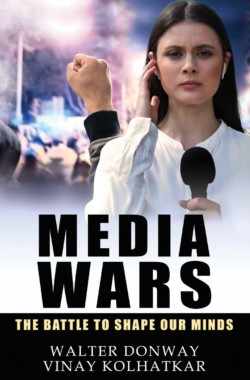Advocacy Journalism and Socialist Revolution
What is “advocacy journalism”?
If you are not sure, the problem is not with you, but the concept. If journalism arose with the newspaper, and has been defined by it, then “advocacy” is part of journalism: editorials, opinion articles, and the tradition of crusading newspapers—for which editors and reporters risked and sometimes gave their lives.
There is a more fundamental role of journalism: news, reporting facts, just the facts.
But there is a more fundamental role of journalism: news, reporting facts, just the facts. And leaving interpretation of the facts to editorials. A clean distinction between facts and opinion.
Some journalists reject the possibility of objective reporting, while others hold that to include the “right” interpretation of the facts makes a “truer” story.
And so what is “advocacy journalism,” as understood today? It is journalism that rolls over any distinction between the news story and the editorial. There is not much disagreement about the definition. The Oxford Research Encyclopedias say that “Its key premise is that journalists participate in the mass-mediated public sphere and that their work deliberately and transparently stands for specific perspectives, with stories actively championing for certain ideas and values.” And many sources add that some journalists reject the possibility of objective reporting, while others hold that to include the “right” interpretation of the facts makes a “truer” story.
The ideological root—and rationalization—of blurring or denying the difference between fact and opinion is the philosophic doctrine called “postmodernism.”
Postmodernism, derived from the 19th century German philosophical movement called “the anti-Enlightenment”—the reaction against the philosophical movement for reason, individualism, political freedom, and free markets—begins with the premise that there is no knowable reality. All alleged “truths” are rationalizations for political power; political arguments are merely armaments in the struggle for such power.
According to postmodernism, this struggle is between the exploiters and the exploited, those in power and the powerless. If so, there is no distinction between “facts” and “advocacy.” All assertion of “fact” is disguised advocacy.
And so, journalism can drop the pretense at supposed “news stories” verses editorials and opinion columns. Honesty, on this view, requires journalists to advocate the “truth,” which means advocate for the allegedly exploited and powerless. Valid journalism becomes “advocacy of the right politics on behalf of the right side.”
Advocacy journalism is not new. Anti-Enlightenment philosophy from 19th century German scholars and universities—then respected, admired, and imitated worldwide—increasingly influenced American universities and scholarship. Throughout the 20th century, “postmodernism—made explicit (and named) by a new European school of philosophy—took hold in American higher education. It shaped the views of every profession, including the professoriate, journalists, politicians, writers—anyone, indeed, involved with ideas.
But principles, when unchallenged, evolve toward greater consistency or logical extremes. In times of perceived crisis, consistent dedication to those principles becomes a rallying cry.
Nothing has aroused, infuriated—and threatened—intellectuals and politicians of the political left more than the election of Donald Trump to the presidency. It upset what appeared to be a reliable momentum toward socialism not of the communistic stripe, with public ownership of the means of production, but German-style “national socialism,” with government dictation to nominally private businesses and government responsibility for our “welfare” (paid for by taxing away our financial resources and heaping up debt for future generations to pay).
Postmodernism sees this through the lens of “identity politics.” Postmodernism is collectivism. It is a collectivism not primarily of economic “class”—traditional Marxism-Leninism. It is the collectivism of the tribe: race, ethnicity, immigrant nationality. But also of assumed victim groups: Blacks, Muslims, the disabled, women, sexual variants, etc. As “neo-Marxists,” the postmodernists are wedded to new collectives.
What was once the “responsible,” “mainstream” American press, committed in theory to reporting the facts—and separately, opinion—has collapsed into pure advocacy.
With the looming 2020 presidential election pitting President Donald Trump against challenger Democrat Joseph Biden, we see pure, assertive, unapologetic advocacy journalism. What was once the “responsible,” “mainstream” American press, committed in theory to reporting the facts—and separately, opinion—has collapsed into pure advocacy. It appears to be a generational change. My example is the U.S. “newspaper of record” and leading international voice of America, the New York Times. But what I say applies, as well, to network and cable news.
At the Times, with intensity heretofore unknown, advocacy journalism became dominant during the 2016 presidential election. It was the first postmodernist election. It was the first election that placed identity politics above any other consideration. Every attack upon candidate Donald Trump reflected identity politics. Trump and his supporters were racist, xenophobic, anti-immigrant, sexist, mockers of the disabled, purveyors of fat-shaming … It was as if there were no other issues, nothing else at stake, in the campaign for the American presidency. Indeed, the only other line of attack, one continued after the election and to this day, was the unending search for a crime that could be pinned on Trump, his associates, his businesses, his family.
Four years later, as the 2020 election heats up, Times “news” stories openly and unabashedly campaign for defeat of President’s Trump’s reelection bid. To an extent I never have seen in half a century of following the Times, it is a “party newspaper,” on the European model, campaigning for Democratic presidential nominee Joe Biden. With the selection of Senator Kamala Harris, a woman of Jamaican and Indian ancestry (who self-idenifies as African American), as his vice-presidential running mate, the campaigning became blatant cheerleading.
I am not speaking of columns and editorials, utterly predictable paeans to every postmodernist position, and campaigns ads for Biden and against Trump. Given over wholly to advocacy, Times news stories interpret the news for readers and tell them what to think. In reporting statements of President Trump, it is common for a news story to begin: “President Trump today said, falsely, that …” An August 17 story, not labeled “news analysis,” had the headline: “Trump Steps Up His Assault on Biden with Scattershot Attacks, Many False.”
Of course, writing news stories that are opinion pieces is only half of advocacy journalism. Just as important, or more so, is choosing what to report. Is it a front-page story that the president played a game of golf during the months-long COVID-19 crisis? For the Times and mainstream news, yes.
The extremity of today’s journalistic advocacy called for rationalization, a “cover.” A typical attempt was made in the HuffPost. In “Advocacy Journalism is Polarizing Our Country,” Larry Atkins, who teaches journalism at Temple and Acadia Universities, explained that with the rise of “websites, talk radio, cable TV, and blogs”—and the decline of newspaper readership—advocacy journalism had become a big problem. “Mainstream” news organizations like newspapers and the big networks, of course, had editors and fact checkers. Alas, the “new” media simply did not have the same standards.
This was a relatively early defense of the mainstream media against charges of advocacy journalism, published in 2014, by making the accusation against those who dared to disagree. Since then, social media such as Facebook and Twitter have exploded onto the scene. The left-liberals, including especially the Times, blame social media above all for election of Donald Trump—despite the mainstream media’s own ferocious campaign of attacks, smears, and scandalmongering to defeat him. Almost the day after the 2016 election, there began sustained attacks on social media for “fake news,” unedited and untrammeled opinion, serving as a platform for the “alt-right” (allegedly neo-Nazis, KKK, white supremacy, racism, and, well, Trump supporters). A “study” funded by George Soros conducted at the Columbia School of Journalism pointed at Breitbart News. Mark Zuckerberg, CEO of Facebook, became the left-liberal whipping boy for permitting “fake news.” Journalists and Democrats campaigned for government “regulation” of social media (censorship). Zuckerberg responded with defense of freedom of speech (“tired,” “self-serving,” “predictable” arguments, said journalists), but then began highly visible Facebook measures of “self-regulation.” He is urged to imitate the Times, labeling posts “false” and banning “hate speech.”
And so, a fundamental change in the practice of journalism, change rooted in the dominant philosophical movement of our time, and inculcated in generations of college students—including future journalists—is identified solely with social media, scarcely two decades old. This is classic scapegoating.
What social media, in fact, has done is provide a “platform”—an outlet and audience—for viewpoints of millions people at odds with postmodernism and the left-liberal mainstream media. Not least, President Trump has tens of millions of followers on Twitter who daily read his ideas unmediated by journalists, who, in their stories, of course, would label them “false,” as a “service” to their readers. Twitter, too, is under intense pressure to “regulate” truth and “hate speech.”
Between now and the November 3 election, you will witness the mainstream media’s final abdication of its defining role: news reporting.
Between now and the November 3 election, you will witness the mainstream media’s final abdication of its defining role: news reporting. A new generation of reporters and editors, including at the Times, has been preparing for this by intimidating—in some cases, driving out—colleagues who fall short of political correctness. As I have written elsewhere, some writers and editors trying to fight the straitjacket of postmodernist doctrine simply have given up and walked out.
The Atlas Society, an early and cogent critic of postmodernism and its impact on journalism, wrote in 2001 that: “If journalists … are allowed to get away with spouting postmodern ‘news analysis,’ they will be laying the groundwork for introducing similar procedures and institutions into the country at large.”
Well, more and more Times stories are slapped with the label “News Analysis.” That means all opinionated analysis, not much news. Just the claim to be “news,” which most readers seek out first. And so, an August 17 a “news analysis” led off with “… it is not normal for a president to employ transparently racist and sexist attacks. Or pressure his attorney general to prosecute his foes with an election looming. Or resist providing more money for the Postal Service in order to stop people from voting by mail. Or embrace a conspiracy theorist running for Congress. Or condemn American cities to “rot.”
You mentioned analyzing the “news”?
So far, they have indeed “gotten away with it.” And made advocacy journalism blatant, unapologetic, near universal. At the same time, identity politics, including racial quotas, have become standard in American universities as has the myth that the universities have become a “rape culture.” And elections—none more than the one now underway—have become contests between identity politics (Democrats) and all other issues and concerns (Republicans).
(As an aside, just as in 2016 Democrats did not trust identity politics to win the election but sought desperately for a crime to pin on Trump, so in 2020, they are striving to blame Trump mismanagement for a high pandemic death toll. But New York State Democratic Governor Andrew Cuomo notoriously took full charge from the outset, exercising virtually unlimited power over the economy and every other activity. He spent hours on television daily issuing directives. Far-left Democrat Bill de Blasio, mayor of New York City, if anything was more of a Covid-19 czar. Yet, with less than 6 percent of the U.S. population, New York State had 20 percent of U.S. pandemic deaths. Excess deaths caused by mismanagement?) If these tactics succeed, and Biden and Harris are elected on a platform and in a campaign focused on race, including proposed trillions of dollars in “reparations” to Blacks, then the country-at-large will be set up for a revolution pitting the “oppressors” against the “oppressed.”
The left, at last, will have a new socialist revolution—this time a “neo-Marxist” race revolution instead of a Marxist “proletarian revolution”—to cheer. That has been postmodernism’s goal from the start.
« What Does Ayn Rand Really Think? Part II: What Does Ayn Rand Really Think? »










